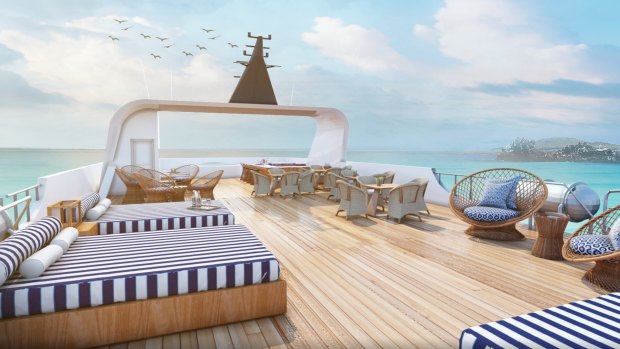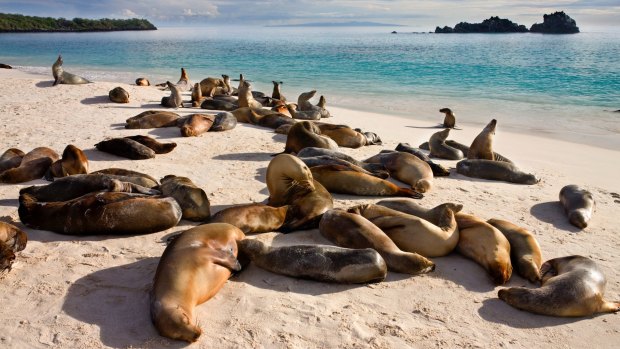This was published 6 years ago
Galapagos Islands: Cruise on boutique eco-ship MV Theory

The sun deck on board Ecoventura's MV Theory.
Everyone's talking about sustainable tourism these days, but there's a lot more to it than banning plastic straws in ships and hotels, laudable though that is. One operator who knows more than most about environmentally friendly travel is Santiago Dunn, the executive president of Galapagos cruise company Ecoventura.
Dunn, who worked in his family's Ecuador-based travel business from an early age, is hosting the maiden voyage of Ecoventura's newest ship, the ultra-chic, 20-guest MV Theory.
"We started our green journey in 1999, when we were guinea pigs for the Rainforest Alliance in New York. They wrote their Smart Voyager certification program based on us," he says. "To qualify for certification by 2000, we made a lot of changes to our vessels – replacing cooling gases from air-conditioning and cooling systems to ozone-free, upgrading the hulls with lead-free paint, initiating on board recycling and changing our itineraries to seven nights a week rather than three or four, to reduce the passenger load to the islands."

A colony of sea lions snooze at Gardner Bay on Espanola in the Galapagos Islands, Ecuador.Credit: Shutterstock
In 2006, Ecoventura became the first carbon neutral operation in the Galapagos. Two years later, its motor-yacht MY Eric – which is being replaced by new boutique eco-ship MV Theory – became the first hybrid-fuel vessel to sail the archipelago. Then there are partnerships and active projects with the World Wildlife Fund, Charles Darwin Foundation, Ecology Project International and more. Dunn walks the eco-talk with boundless enthusiasm and hefty financial investment.
As our conversation moves on to the nature of luxury expeditions (Origin and its sister ship Theory are members of the prestigious Relais & Chateaux organisation) there's a whale-sighting alert. Everyone on deck rushes to the port side to see a pod of orcas coasting through the waves and even though he has seen hundreds of the majestic mammals over the years, Dunn is just as excited as the passengers.
During the seven-night cruise of the southern and central islands, which starts and ends at San Cristobal, we have wildlife encounters galore. On board naturalist guides Yvonne Mortola and Billy Maquilon live and breathe Galapagos – their combined knowledge about birds, animals, marine life, plants, insects, geology, ocean conditions and the climate would fill a couple of encyclopaedias. They are also great company, whether at dinner or leading a Zodiac expedition.
"Be careful what you sit on to change your shoes in case it's alive," Maquilon quips when we wade through clear tropical water for a walk along the sparkling white silica-sand beach at Cerro Brujo. Those rock-like lumps on the beach are sleepy sea lions and like all the animals and birds we see, they are famously unafraid of humans and hardly stir when we pass by.
As the beach walk turns into a bush hike, Mortola points out the difference between endemic and native species – endemic animals live exclusively in a specific region (think koalas in Australia) whereas native species can be found in several areas. It gets more complicated when you add introduced and sub-species to the mix.
Giant Galapagos tortoises, marine and land iguanas and lava lizards are endemic to the archipelago, as are Darwin's finches (13 different species), flightless cormorants, Galapagos mocking birds and the Galapagos penguin, the only penguin that lives north of the equator. Endearing, comical blue-footed boobies and magnificent frigate birds (that's their full name, or fregata magnificens) are natives.
We tick off dozens of sightings of these and many more incredible creatures on island hikes – well, only one penguin on a Zodiac trip – and daily excursions ashore are interspersed with off-beach and deep-water snorkelling expeditions. Ecoventura's guide-to-guest ratio of one to 10 is higher than the Marine Park-mandated one to 16, which allows greater flexibility for excursions. Active hikers, say, might want to power up a volcanic peak while slower-paced photographers might prefer to wait for the sun to hit a hawk's beak to get their perfect shot; groups can be split depending on their interests or limitations.
Fortunately, our contingent of 20 is evenly matched – none of us can get enough of snorkelling. The water is blissfully warm and every day we see thousands of dazzling tropical fish, sea lions performing acrobatic underwater tricks, graceful green turtles and white-tipped sharks. On one unforgettable deep-water snorkelling trip we are thrilled to spot hammerhead sharks, and then are ecstatic when dozens of spotted-eagle and manta rays glide beneath us in a hypnotic display that even veteran diver Billy says is phenomenal.
Life on MV Theory is phenomenal, too. After every outing we are welcomed back on board by friendly bartenders offering freshly pressed juices and canapes. The bars on the sun deck and in the cool, super-stylish lounge are always open and if you feel the need for any extra exercise after all that hiking, snorkelling and swimming, there's a small but well-equipped gym.
Dining is a highlight. Chef Estuardo Vileli creates dishes that combine Ecuadorian, Latin American and European influences, using both locally farmed and imported products, most of which are sustainable and organic. Not surprisingly, seafood features on most menus. Estuardo demonstrates how to make ceviche one afternoon and the ship's little library stocks a beautiful cookbook that includes recipes for dishes we sample on the cruise.
The ambience on board is more private yacht than expedition vessel and all three 20-guest ships in the fleet can be fully chartered. Dunn says the Galapagos increasingly appeals to multi-generational families and he's seeing guests who first visited 30 years ago returning with their grand-children.
During the summer holidays, Ecoventura devotes one ship to family cruises; the ships each have two interconnecting and two triple cabins. Separate expeditions can be tailored for children who love hearing stories from a guide who makes funny animal noises (Maquilon's sea lion impersonations make him perfect for the job), while their parents can join more scientific-oriented trips.
Although he describes his ships as "lovely hardware", Dunn says the focus of Ecoventura's operations is always on sharing the unspoilt beauty of this extraordinary wilderness with guests who will return home as passionate defenders of the environment.
As he says, "Conservation is a responsibility that should be a commitment from all of us on this planet."
FIVE THINGS TO KNOW BEFORE YOU GO
WHEN TO CRUISE
The Galapagos archipelago is a year-round destination and although there are two seasons (warm and wetter January to June; cool and dry July to December), air and water temperatures don't vary a lot and despite being on the equator it's a Pacific "dry zone" so overall rainfall is low. The busiest tourist months are December and January and June to August.
GETTING THERE
Whether you fly via the US or New Zealand, expect a journey of at least 28 hours. Flights arrive either at Quito, Ecuador's capital, or Guayaquil, from where you fly to San Cristobal or Baltra. Flights to the islands leave in the morning so you will need to book at least one night's accommodation.
RED TAPE
Australian passport holders can stay in Ecuador for up to 90 days without a visa. At Quito or Guayaquil airports, you need to buy a $US20 Transit Control Card at the INGALA counter to be used when entering and leaving the islands. At the Galapagos airport you need to pay the Galapagos National Park entrance fee of $US100.
PACKING ESSENTIALS
Whatever time of year you go, take an underwater camera; a small waterproof bag for taking kit ashore on Zodiac trips; lightweight hiking shoes and/or Teva-style sandals; a rash top for snorkelling; a breathable long-sleeve shirt; non-spray insect repellent (although mosquitoes aren't generally a problem); reef-safe sunblock and a hat.
BACKGROUND READING
If Charles Darwin's ground-breaking On the Origin of the Species seems a bit forbidding, try his engaging memoir The Voyage of the Beagle, published in 1839. Lonesome George: The Life and Loves of the World's Most Famous Tortoise, by Henry Nicholls, tells the story of the much-loved giant tortoise and Galapagos conservation icon who died in 2012. John E. Treherne's The Galapagos Affair delves into the bizarre lives of German settlers on the Galapagos island of Floreana in the 1930s.
TRIP NOTES
Sally Macmillan travelled as a guest of Eclipse Travel.
MORE
CRUISE
Ecoventura operates seven-night cruises on luxury 20-passenger yachts MV Theory, identical sister MV Origin and motor-yacht Letty that depart every Sunday, year-round. Fares start from $7850 twin share and include all meals, shore excursions, drinks and use of three-millimetre wetsuits, snorkelling gear, stand-up paddleboards and kayaks. See ecoventura.com
Sign up for the Traveller Deals newsletter
Get exclusive travel deals delivered straight to your inbox. Sign up now.